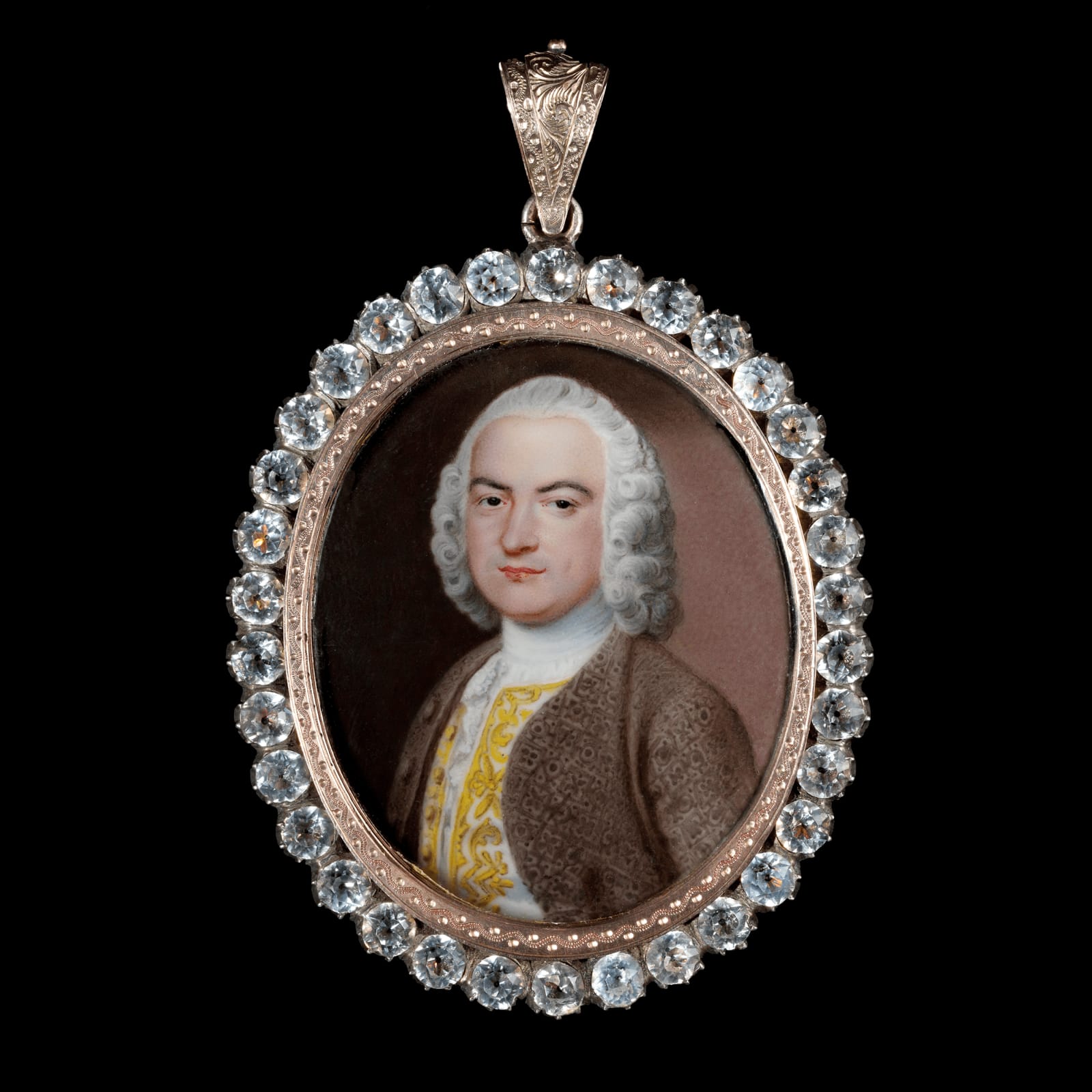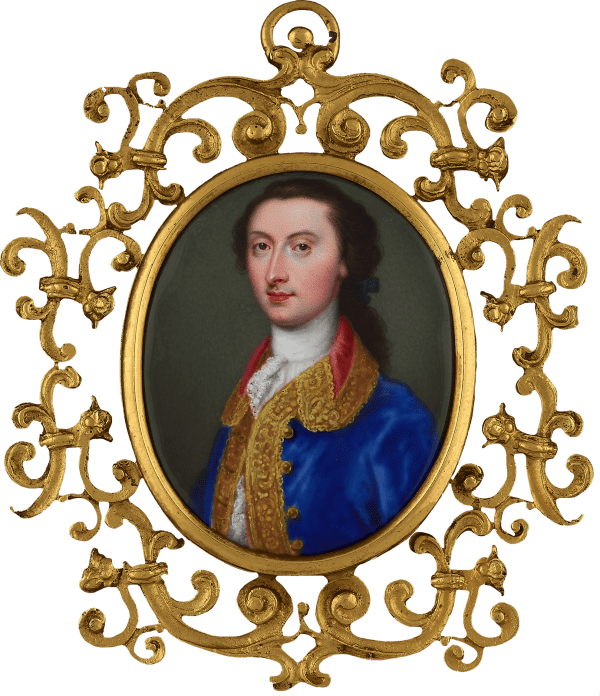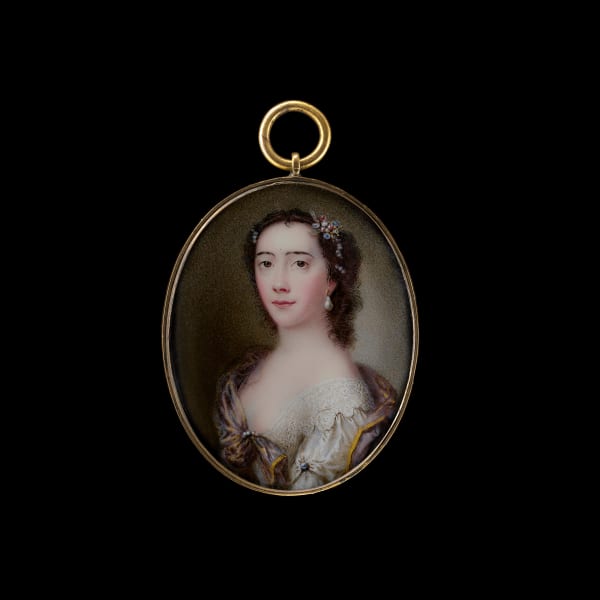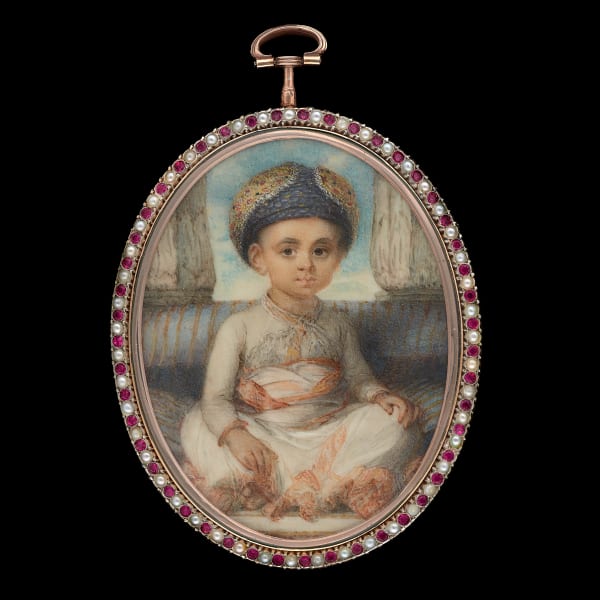
Jean André Rouquet
Portrait enamel of a Gentleman, wearing brown coat over white waistcoat embroidered with gold thread, powdered wig, c. 1740
Enamel on copper
Oval, 1 ¾ in. (44 mm) high
Philip Mould & Co.
%3Cdiv%20class%3D%22artist%22%3EJean%20Andr%C3%A9%20Rouquet%3C/div%3E%3Cdiv%20class%3D%22title_and_year%22%3E%3Cspan%20class%3D%22title_and_year_title%22%3EPortrait%20enamel%20of%20a%20Gentleman%2C%20wearing%20brown%20coat%20over%20white%20waistcoat%20embroidered%20with%20gold%20thread%2C%20powdered%20wig%3C/span%3E%2C%20%3Cspan%20class%3D%22title_and_year_year%22%3Ec.%201740%3C/span%3E%3C/div%3E%3Cdiv%20class%3D%22medium%22%3EEnamel%20on%20copper%3C/div%3E%3Cdiv%20class%3D%22dimensions%22%3EOval%2C%201%20%C2%BE%20in.%20%2844%20mm%29%20high%3Cbr/%3E%0A%3C/div%3E
To view all current artworks for sale visit philipmould.com Jean André Rouquet was one of the most successful enamellists of the early eighteenth century. The son of Huguenot refugees,...
To view all current artworks for sale visit philipmould.com
Jean André Rouquet was one of the most successful enamellists of the early eighteenth century. The son of Huguenot refugees, he was born in Geneva where he learned his trade as an enamellist. At some point during the 1720s the artist moved to London where he quickly established his position as one of the pre-eminent miniaturists of his day and where the present work was most likely completed.
Although he worked in England, Rouquet continued to maintain his links to the Continent, exhibiting in Paris in 1753, 1755, and 1757. Indeed, it was in the French capital that his professional standing was affirmed with his receipt, in 1755, from Louis XV, by whom he was asked to paint a portrait of his famed mistress, Madame du Pompadour. His star still in the ascendant, Rouquet was elected to the Academie Royale de Paris in the following year. Tragically, however, Rouquet’s fortunes were not to last. His wits assaulted by mental illness, he was incarcerated in an asylum, where he died in 1758.
Although he assimilated himself into the artistic scene in England, Rouquet successfully made use of his status as a foreigner to provide an outsider’s look on British art and was the author of several successful publications. Among these were the first attempts to explain and export the engravings of his friend, William Hogarth (whose enamel portrait by Rouquet is in the National Portrait Gallery, London) to an overseas audience. Whilst supportive of Hogarth, Rouquet maintained a critical distance from the arts of contemporary England, adopting the dispassionate yet highly observant stance of the outsider. This attitude was summarised in his highly successful 1755 Etat des Arts en Angleterre in which the artist by turns defended the English arts against the attacks of contemporary French commentators and lambasted the English themselves for their indifference to their rapidly developing artistic culture.
During his relatively short career, Rouquet was clearly successful – his enamels competing with those of his contemporary Christian Friedrich Zincke. Rouquet’s clientele came from the political and intellectual elite of England, his intelligent commentary perhaps attracting those patrons (for example, a portrait of British statesman William Pitt is in the collection of the Victoria and Albert Museum). Making enamels was a highly labour-intensive practice and commissions were expensive compared to traditional portrait miniatures painted in watercolour on ivory or vellum.
Jean André Rouquet was one of the most successful enamellists of the early eighteenth century. The son of Huguenot refugees, he was born in Geneva where he learned his trade as an enamellist. At some point during the 1720s the artist moved to London where he quickly established his position as one of the pre-eminent miniaturists of his day and where the present work was most likely completed.
Although he worked in England, Rouquet continued to maintain his links to the Continent, exhibiting in Paris in 1753, 1755, and 1757. Indeed, it was in the French capital that his professional standing was affirmed with his receipt, in 1755, from Louis XV, by whom he was asked to paint a portrait of his famed mistress, Madame du Pompadour. His star still in the ascendant, Rouquet was elected to the Academie Royale de Paris in the following year. Tragically, however, Rouquet’s fortunes were not to last. His wits assaulted by mental illness, he was incarcerated in an asylum, where he died in 1758.
Although he assimilated himself into the artistic scene in England, Rouquet successfully made use of his status as a foreigner to provide an outsider’s look on British art and was the author of several successful publications. Among these were the first attempts to explain and export the engravings of his friend, William Hogarth (whose enamel portrait by Rouquet is in the National Portrait Gallery, London) to an overseas audience. Whilst supportive of Hogarth, Rouquet maintained a critical distance from the arts of contemporary England, adopting the dispassionate yet highly observant stance of the outsider. This attitude was summarised in his highly successful 1755 Etat des Arts en Angleterre in which the artist by turns defended the English arts against the attacks of contemporary French commentators and lambasted the English themselves for their indifference to their rapidly developing artistic culture.
During his relatively short career, Rouquet was clearly successful – his enamels competing with those of his contemporary Christian Friedrich Zincke. Rouquet’s clientele came from the political and intellectual elite of England, his intelligent commentary perhaps attracting those patrons (for example, a portrait of British statesman William Pitt is in the collection of the Victoria and Albert Museum). Making enamels was a highly labour-intensive practice and commissions were expensive compared to traditional portrait miniatures painted in watercolour on ivory or vellum.
Provenance
Private British Collection
Share
- X
- Tumblr
Related artworks
-
 Jean André RouquetA young Lady, wearing pale pink dress, flowers at her corsage and in her curled hair, c. 1740
Jean André RouquetA young Lady, wearing pale pink dress, flowers at her corsage and in her curled hair, c. 1740 -
 Christian Friedrich ZinckeA Nobleman, probably a member of the Townshend family, c. 1740
Christian Friedrich ZinckeA Nobleman, probably a member of the Townshend family, c. 1740 -
 Rupert BarberA Lady, wearing a gold-trimmed lilac shawl over a white dress, c. 1745
Rupert BarberA Lady, wearing a gold-trimmed lilac shawl over a white dress, c. 1745 -
 Ozias HumphryThe Sahibzada, Vizir Ali Khan, later Nawab Wazir Of Oudh (1780-1817), wearing orange and white robe, blue nawabi turban, seated cross-legged on a gold and purple striped cushion; marble column background, 1786
Ozias HumphryThe Sahibzada, Vizir Ali Khan, later Nawab Wazir Of Oudh (1780-1817), wearing orange and white robe, blue nawabi turban, seated cross-legged on a gold and purple striped cushion; marble column background, 1786 -
 Nathaniel Hone the ElderA portrait enamel of a Lady, traditionally thought to be Mary Boyle, Countess of Cork and Orrery (1746–1840), wearing pink dress with lace collar and black bow held with double row of pearls, further pearls decorate her upswept hair, c. 1760
Nathaniel Hone the ElderA portrait enamel of a Lady, traditionally thought to be Mary Boyle, Countess of Cork and Orrery (1746–1840), wearing pink dress with lace collar and black bow held with double row of pearls, further pearls decorate her upswept hair, c. 1760




